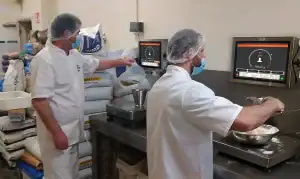Crop Chemical Manufacturing, Simplified.
Ag-chem isn’t a “nice-to-have” compliance exercise wrapped around a batch plant—it’s a high-stakes business where one mis-picked lot, one off-spec fill, or one labeling slip can trigger disposal, rework, or a regulator at your door. V5 fixes that by hard-gating execution, embedding quality in the run, enforcing material governance, and syncing reality to the plan. The payoff: tighter batches, faster release, cleaner audits, and traceability that stands up anywhere you sell—U.S., EU, UK, APAC. This is how you get batch performance, quality control, and international compliance to pull in the same direction.
Control beats hope. V5 makes the right way the only way—and proves it with complete, tamper-evident records.
1) MES: Batch Execution With Teeth
Most ag-chem losses are born on the floor: wrong registered formulation, wrong weigh, wrong sequence. V5’s MES locks the gates with barcode/GS1-128 validation, device-level weigh targets and tolerances, forced step sequencing, and full electronic batch history. Operators can’t proceed until the step is in spec; supervisors see exceptions live, not at shift-end. The result is right-first-time execution that lifts yield and cuts rework.
Where batches drift—and how V5 stops it
- Off-target weighs: Device-level tolerance control blocks “close enough” giveaways that become scrap or rework.
- Wrong lot/expired stock: Scan-to-use validation of lot/expiry at the scale; mis-picks can’t slip through.
- Skipped critical checks: Sequence control forces scale verifications, clean-downs, hazardous zone confirmations, and sign-offs before the batch can advance.
- Paper lag: E-records build as you run; reviews happen in hours, not days.
Because label and establishment rules on pesticides are unforgiving, MES also enforces the data needed downstream—so your finished labels and e-records align by design, not by best effort.
2) QMS: Quality Built Into the Line (Not After It)
In ag-chem, “we’ll test it later” is how good material becomes quarantined inventory. V5 moves quality in-line: sampling plans tied to risk, mandatory in-process checks, deviation capture with root cause, and closed-loop CAPA. The quality system runs inside execution—so drift is caught before it becomes a batch problem. You get faster release because QA reviews facts (complete, time-stamped, tamper-evident data), not handwriting.
QMS controls that cut scrap and protect labels
- Training gates: Only qualified operators can run steps that affect safety, efficacy, or label claims.
- Spec checks on schedule: System-prompted tests hold the batch before drift becomes a disposal event.
- Document control: Only current SOPs/labels are available; obsolete text can’t reappear.
- Deviation → CAPA → proof: Recurrence is blocked with systemized fixes—not sticky notes.
Facilities still owe Safety Data Sheets under worker hazard communication. V5 centralizes SDS control and change-tracking so workers see the right hazards and PPE every time.
3) WMS: Material Governance Where It Matters
The cheapest waste to kill is the waste you never stage. V5’s WMS enforces FEFO/FIFO, hazardous/allergen zoning, scan-verified picks, and live location-level inventory. In pesticides, that matters twice: you avoid expired/mismatched inputs and you keep your device/product labels honest. GS1-128 labels carry lot/expiry/serials; V5 prints and validates them at the source.
Silent loss eliminators
- FEFO enforcement: Oldest acceptable stock moves first; fewer write-offs.
- Zone segregation: Hazard classes and cross-contact risks are physically gated on the scanner.
- Lot lineage to the truck: Pallets/cases keep their truth to shipment—returns don’t become traceability sinkholes.
- Live counts: No emergency over-orders or surprise shorts before a campaign.
If you refill or repackage, V5 also enforces container/containment rules: refillable vs. non-refillable, correct net contents, and the ability to mark the correct establishment number on the finished label.
4) Planning Sync: Close the Gap Between ERP and the Floor
Waste thrives between the plan and what actually ran. V5 keeps orders, BOMs, lots, label content, and shipment data aligned end-to-end. Schedulers see the true availability of lots (not theoretical), planners pull actual yields to refine standards, and labels inherit the correct identifiers by batch and pack. That means fewer “maybe” runs and fewer “whoops” batches.
What “single source of truth” looks like
- Planned vs. actual yields: Deviations show up live; fix the setting, don’t massage a spreadsheet.
- Real availability: Production doesn’t start on the wrong lot because “that’s what the clipboard said.”
- Recall-readiness: One query gives upstream ingredients and downstream customers in minutes—not days.
5) Regulatory Reality (U.S.): Build It Into the System
Labels & establishment numbers. Pesticide labels must carry the registration number and the producing establishment’s number. V5 stores them as master data and renders them on labels and records every time—no manual transcribe, no mismatch.
Books & records. Producers must maintain detailed production and distribution records. V5’s e-batch records, shipments, deviations, and waste capture map directly to those requirements, and records are inspection-ready.
Hazard communication & SDS. Even where product labels follow pesticide-specific rules, workers still need accurate SDS and hazard communication. V5 centralizes SDS versions and pushes the current sheet to devices so the floor always sees the right information.
Hazmat shipping. Transport rules govern shipping papers, package marking/labels, and vehicle placarding. V5 prints compliant marks and keeps shipping data consistent with the batch.
Inventory thresholds. Storage triggers site reporting above defined thresholds. V5 tracks on-site inventory by location and weight so you know exactly what crosses a threshold.
Waste manifests. Hazardous waste shipments require cradle-to-grave tracking. V5’s waste capture feeds manifests with line/shift/reason-code detail so the paperwork matches reality.
6) International: CLP, Notifications, and 2D Barcodes
Selling into the EU? CLP governs classification, labelling, and packaging. Notification obligations and unique identifiers are moving onto labels and into submissions. V5 holds formulation–identifier mappings as master data, prints them on the label, and keeps notification-relevant fields consistent across systems.
Other regions add their own twists (e.g., manufacturing licensing and GMP principles). V5’s electronic records, training competence checks, and controlled documentation align with those expectations.
The world is moving to richer 2D barcodes. V5 prints and validates GS1-128 today and can add QR/Data Matrix for batch, expiry, identifiers, and claim links—ready for dual coding during the transition.
7) Waste Capture & Mass Balance: Make Loss Visible—and Unrepeatable
You can’t improve what you won’t measure. V5 captures waste at the point of loss with reason codes, operator/device, and location so conversations shift from blame to causes. Spills, trim, aborted batches, over-weights, labeling rejects, mis-picks—each becomes structured data that explains variance and guides fixes. Roll it into mass balance by step, line, shift, and product family. That’s how OEE and RFT actually move, not just report.
- Fix the largest delta step first—charge/weigh → mix → fill → pack—don’t “optimize everything.”
- Turn recurring reasons into rules (forced checks, label verifications, zone scans) so they can’t recur silently.
- Make accountability visible by line/shift; improvements replace lectures.
8) Snapshots From Ag-Chem Floors
Formulation: Ratio Drift & Off-Spec
Problem: Micro-ingredient over- or under-dose; substitution without SDS check; label claims at risk.
V5 fix: Device-locked tolerances, barcode validation, and in-process checks; SDS tie-in at pick.
Result: Tighter potency and fewer hold/rework loops; labels match formulation specs.
Packaging: Label Integrity & Establishment Numbers
Problem: Wrong establishment number or missing registration number on a run; recall risk for misbranding.
V5 fix: Labels generated from controlled data; scan-verified against order and batch.
Result: Clean audits; no scramble to correct finished goods.
Warehouse: Expiry & Mis-picks
Problem: Non-FEFO picks and expired raw inputs create scrap or off-label claims.
V5 fix: FEFO enforcement, zone segregation, scan-to-use.
Result: Lower write-offs and zero “made a perfect batch…of the wrong thing.”
Waste & Shipments: Hazmat, Manifests, Traceability
Problem: Shipment paperwork and waste manifests lag production truth; placards and package marks mismatched.
V5 fix: Shipping marks and papers generated from batch data; manifest-ready waste capture; transport alignment.
Result: Faster, cleaner shipments and cradle-to-grave compliance.
9) The KPIs That Actually Move
- Right-First-Time (RFT): Enforced steps and in-line checks cut early-step errors and rework.
- Yield & Giveaway: Tight scale control and SPC keep weighs on target.
- Inventory Accuracy & Expiry: WMS + FEFO reduce write-offs and emergency buys.
- On-Time Release: E-records build as you run; QA reviews facts, not handwriting.
- Recall Readiness: Upstream/downstream exposure in minutes; lots, pallets, customers in one pull.
- OEE: Availability, performance, and quality improve together when execution and quality are embedded.
10) Start Small, Win Fast, Scale
- Pick the biggest leak: Weigh room variance? Start with MES device gating. Expiry/mis-picks? Start with WMS.
- Turn reasons into rules: Every recurring deviation becomes a forced check, prompt, or scanner gate.
- Prove it on one value stream: One SKU family, one month of hard data—yield, RFT, waste saved.
- Wire in planning next: Orders, labels, and lots share one truth across ERP ↔ V5.
- Lock it in: Daily stand-ups on RFT, yield, rejects, expiry; dashboards, not heroics.
Bottom Line
Waste isn’t destiny; it’s what leaks through uncontrolled steps. V5 closes the gaps—execution, quality, materials, planning—then measures what’s left so you can kill it for good. That’s how ag-chem manufacturers hit batch performance targets, release faster, and pass audits without a war room. Start where the losses are loudest; scale once the numbers make the case.
Explore how this plays out in your world:
Ag-Chemical ·
Food Processing ·
Plastics & Resin ·
Pharmaceutical ·
Consumer Products ·
Medical Device


